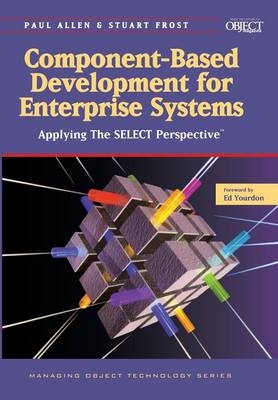
Component-Based Development for Enterprise Systems
Applying the SELECT Perspective
Seiten
1998
Cambridge University Press (Verlag)
978-0-521-64999-5 (ISBN)
Cambridge University Press (Verlag)
978-0-521-64999-5 (ISBN)
Presents the SELECT Perspective, a component-based approach that addresses the demands of large-scale, complex enterprise software development problems.
This ground-breaking book distills the experience of the author in dealing with problems in industry that can be solved by using the SELECT Perspective. A pragmatic component-based approach for the development of enterprise systems, the SELECT Perspective comprises a unique blend of techniques, architecture, and process. Enterprise software development presents challenges of sheer scale and complexity that continue to accelerate at a terrific pace. Businesses are becoming increasingly adaptive and are calling for software that is more and more flexible. Component technology holds the promise of solving these problems, but there are some complications. For example, many organizations continue to struggle with the challenge of integrating their legacy systems with the newer technology. The approach in this book offers a streamlined set of modeling techniques based on the Unified Modeling Language (UML); uses a serviced-based architecture that provides an overall design philosophy for reusable software that addresses the needs of the business, not the technology; and is a clearly defined software process that provides guidance on how to employ the knowledge base of available techniques.
This ground-breaking book distills the experience of the author in dealing with problems in industry that can be solved by using the SELECT Perspective. A pragmatic component-based approach for the development of enterprise systems, the SELECT Perspective comprises a unique blend of techniques, architecture, and process. Enterprise software development presents challenges of sheer scale and complexity that continue to accelerate at a terrific pace. Businesses are becoming increasingly adaptive and are calling for software that is more and more flexible. Component technology holds the promise of solving these problems, but there are some complications. For example, many organizations continue to struggle with the challenge of integrating their legacy systems with the newer technology. The approach in this book offers a streamlined set of modeling techniques based on the Unified Modeling Language (UML); uses a serviced-based architecture that provides an overall design philosophy for reusable software that addresses the needs of the business, not the technology; and is a clearly defined software process that provides guidance on how to employ the knowledge base of available techniques.
1. Overview; 2. The perspective architecture; 3. Business process modeling; 4. Use case modeling; 5. Class modeling; 6. Object interaction modeling; 7. State modeling; 8. Business oriented component modeling; 9. Component modeling of legacy assets; 10. Deployment modeling; 11. The perspective process; 12. The solution process; 13. The perspective process; 14. Perspective teams; 15. Case study: VWX Software Inc.; Appendix A. Deliverables; Appendix B. Relational mappings; Glossary.
| Erscheint lt. Verlag | 13.1.1998 |
|---|---|
| Reihe/Serie | SIGS: Managing Object Technology |
| Verlagsort | Cambridge |
| Sprache | englisch |
| Maße | 170 x 244 mm |
| Gewicht | 770 g |
| Themenwelt | Informatik ► Office Programme ► Outlook |
| Informatik ► Software Entwicklung ► Objektorientierung | |
| ISBN-10 | 0-521-64999-4 / 0521649994 |
| ISBN-13 | 978-0-521-64999-5 / 9780521649995 |
| Zustand | Neuware |
| Haben Sie eine Frage zum Produkt? |
Mehr entdecken
aus dem Bereich
aus dem Bereich
Buch | Softcover (2022)
Markt + Technik Verlag
CHF 20,90
Band 1: Grundlagen des digitalen Zeitalters
Buch | Softcover (2024)
Springer Gabler (Verlag)
CHF 69,95


